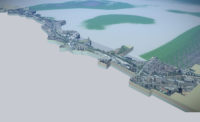It has taken a bit of time, but you have finally moved from CAD to BIM and you are thinking, “Right, I’ve got this now.”
Think again.
Due to the uncanny timing and convergence of market conditions, technology innovation, social wants and government needs, a Smart Cities market is emerging on a global scale that dwarfs any previous notion of the value given to data about the built environment. AEC firms are the authors of an enormous amount of that increasingly valuable data, and there is a lot of money to be made by those who recognize its market potential.
Sometimes described as part of a Big Data program, the Smart City initiatives being implemented in many urban environments around the world today require accurate and authenticated data to work properly. This puts a high value on data usually associated with BIM and Smart Buildings.
Think of the Smart City as a network, with each building as a server. In his book, “Connected Sustainable Cities,” Bill Mitchell calls this a “primitive nervous system” for a city; but in the context of a Smart City, these networks are rapidly evolving into something approximating the advanced nervous systems of higher organisms.
If each building has data (BIM for design and construction and Smart Building data in the form of Facility Management/Building Automation) then, when connected to the City Network (Central Nervous System), interesting things begin to happen. AEC data becomes the digital DNA of Smart Cities.
Many definitions of Smart Cities are emerging, but most have the elements and projects that include a Smart Grid, Smart Buildings, CleanTech and Smart Governance.
Smart Cities are classified in the following matrix:
Energy, Water, Air Quality, Infrastructure, Waste, Public Safety, Education, Healthcare, Green Buildings, Transportation
Specific, Measurable, Achievable, Relevant, and Time-based goals (SMART)



Post a comment to this article
Report Abusive Comment